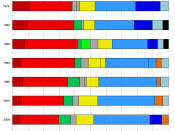TABLE OF CONTENTS
Pages
21. INTRODUCTION �
32. EUROPEAN UNION FISCAL POLICY �
32.1. Issues about Fiscal Policy �
52.2.1. The Relationship between Monetary and Fiscal Policies in EMU �
62.2.2. The Interaction of Fiscal with Monetary Policy in EMU �
72.2.3. Interface Between Fiscal and Monetary Policies in EMU �
82.2.4. The current fiscal rules �
92.2.5. Plan for reforming the fiscal rules �
102.3. The Effectiveness of Fiscal Policy in EMU �
112.3.1. Effectiveness on Growth �
122.3.2. Effectiveness on Inflation �
142.3.3. The Stability And Growth Pact �
152.4. Fiscal Federalism in Europe �
164. STABILIZATION PROGRAMS IN TURKEY TO ADJUST EU FISCAL POLICY REQUIREMENTS (1980-2006) �
164.1. 1980 Stabilization Program �
174.2. 1994 Stabilization Programme and the 16th Standby Agreement �
214.3. 1998 IMF Staff Monitoring Programme �
224.4. 1999 Programme and the 17th Standby Agreement �
244.5 Economic Crisis of 2000-2001 �
264.6. Strengthening the Turkish Economy and the 18th Standby Agreement �
284.7 Inflation Targeting Strategy and the 19th Standby Agreement �
295. COMPARISON OF TURKSISH AND EU FISCAL POLICIES �
295.1. Taxation in Fiscal Policy �
315.2. Effect of Tax Policies on Employment and Labor Costs �
33CONCLUSION �
34REFERENCES �
�
1. INTRODUCTION
There is no precise and universally agreed definition of economic union. However, since the publication of the Delors Report, its definition has been widely used. Paragraph 25 of the Delors Report lists, somewhat arbitrarily, fo ur basic components that form core of the economic dimension of unification:
1. The single market within which persons, goods, services and capital can move freely;
2. Competition policy and other measures aimed at strengthening market mechanisms;
3. Common policies aimed at structural change and regional development; and
4. Macroeconomic policy coordination including binding rules for budgetary policies.
The first two components...


